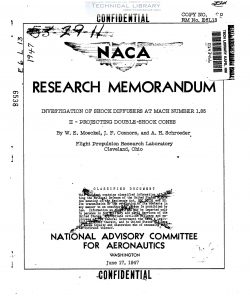naca-rm-e6l13
- Version
- 156 Downloads
- 1.54 MB File Size
- 1 File Count
- March 14, 2017 Create Date
- March 14, 2017 Last Updated
National Advisiory Committe for Aeronautics, Research Memorandum - Investigation of Shock Diffusers at Mach Number 1.85 - II - Projecting Double Shock Cones

An investigation has been undertaken in the Cleveland 18— by
18-inch supersonic tunnel to determine the total-pressure recovery
obtainable at a Mach number of 1.85 with a shock diffuser having
projecting cones designed to produce two oblique shocks ahead of the
diffuser inlet. The variation of total-pressure recovery with tip
projection was investigated for each of four cones with different
included angles. Each cone was investigated with a straight and
with a curved diffuser-inlet section. The effect of angle of attack
and the distribution of static and total pressures at the diffuser
outlet were also investigated for the best configurations.
A maximum total-pressure recovery of 94. 5 percent was attained
with the best configuration at an angle of attack of 0° At an angle
of attack of 5°, this maximum recovery was reduced to 89. 9 percent.
These total-pressure recoveries correspond to efficiencies of kinetic-
energy conversion of 97. 8 percent at 00 and 95. 5 percent at 50 angle
of attack. Several other configurations gave maximum total-pressure
recoveries greater than 93. 0 percent at an angle of attack of OO
With each conez three oblique shocks appeared ahead of the
diffuser inlet instead of the two theoretically predicted. The addi—
tional oblique shock resulted from a bridging of the break in the
cone surface by the boundary layer.
The highest total-pressure recoveries were obtained with subsonic
inlet flow. For outlet areas less than optimum, the total-pressure
recovery dropped to values lower than those obtained with.single-
shock cones.
An investigation of shock diffusers at a Mach number of 1.35 is
being conducted in the Cleveland 18— by 18-inch supersonic tunnel.
Results obtained with a shock diffuser having a single oblique shock
ahead of the inlet are presented in reference 1 and are compared with
theoretically estimated results. A maximum total-pressure recovery
of 92.2 percent was attained.
When the projecting cone is designed with an abrupt increase in
the included angle at some distance from the tip, a second oblique
shock should arise from the break in the contour. A higher total—
pressure recovery should be obtainable with two shocks ahead of the
inlet because the total-pressure ratio for a given reduction in Mach
number is greater across two'oblique shocks than across one.
Four cones having abrupt increases in included angle at some
distance from the tip were designed for investigation in the diffuser
body of reference 1. Each of these cones was used in combination
with a straight and with a curved inlet to determine whether higher
total-pressure recoveries were obtainable with abrupt or gradual
deflection of the entering flow. The total-pressure recovery was
determined for each cone-inlet combination as a function of tip
projection and outlet area. The effect of angle of attack and the
pressure distributions at 0° and 5° angle of attack were determined
for the best configurations.
| File | Action |
|---|---|
| naca-rm-e6l13 Investigation of Shock Diffusers at Mach Number 1.85 - II - Projecting Double Shock Cones.pdf | Download |

Comment On This Post